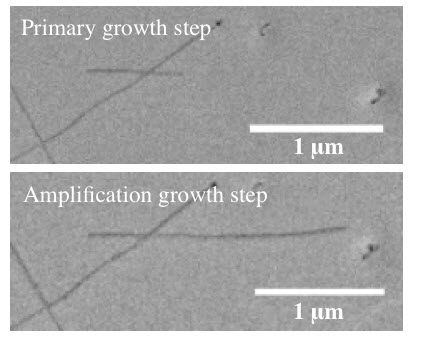‘Amplified’ nanotubes may power the future
July 15, 2011

A single carbon nanotube before and after amplification (credit: Barron Lab/Rice University)
Scientists at Rice University say they have achieved a pivotal breakthrough in the development of a carbon nanotube-based electrical cable that will make an efficient electrical grid of the future possible, a prediction made in 2004 by carbon nanotube co-inventor Richard E. Smalley.
A prime technical hurdle in the development of this “miracle cable,” said Rice chemist Andrew R. Barron, is the manufacture of massive amounts of metallic single-walled carbon nanotubes, dubbed armchairs for their unique shape.
The scientists demonstrated a way to take small batches of individual nanotubes and make them dramatically longer. Ideally, they speculate, long armchair nanotubes could be cut, re-seeded with catalyst and re-grown indefinitely.
“Armchair quantum wire” (AQW) will be a weave of metallic nanotubes that can carry electricity with negligible loss over long distances. It will be an ideal replacement for the nation’s copper-based grid, which leaks electricity at an estimated 5 percent per 100 miles of transmission, the researchers said.
The key was finding the right balance of temperatures, pressures, reaction times and catalyst ratios to promote growth and retard etching.
Alvin W. Orbaek, Andrew C. Owens, Andrew R. Barron, Increasing the Efficiency of Single Walled Carbon Nanotube Amplification by Fe–Co Catalysts Through the Optimization of CH4/H2Partial Pressures, Nano Letters, 2011; 11 (7): 2871 [DOI: 10.1021/nl201315j]